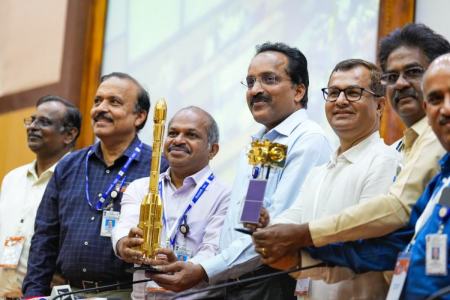
ISRO Chairman S Somanath with other scientists during a press conference after the successful launch of its next generation weather observation satellite INSAT-3DS onboard a GSLV rocket into a precise orbit, in Sriharikota, Saturday, Feb. 17, 2024. A PTI Photo
NEW DELHI (PTI): Often dubbed as "naughty boy" for its spotty success rate, the Geosynchronous Satellite Launch Vehicle-II of ISRO has earned new sobriquets such as "mature", "obedient", "smarty" and "natty" after two consecutive successful launches.
The GSLV on Saturday placed the INSAT-3DS satellite in the Geosynchronous Transfer Orbit (GTO), the second successful mission after it placed the NVS-01 satellite for India's own satellite-based navigation system NavIC.
"Coming to the launch vehicle, GSLV doesn't have a good name ('Naughty Boy') with regards to its performance, but that has been a thing of the past. So far, the rocket and satellites have performed very well," ISRO Chairman S Somanath said, addressing reporters after the successful launch of INSAT-3DS.
Mission Director Tomy Joseph said "the naughty boy has matured as a very obedient and disciplined boy."
"Like PSLV (Polar Satellite Launch Vehicle), GSLV has also become a robust vehicle for ISRO," he said, remarks that were welcomed with applause.
Vikram Sarabhai Space Centre Director S Unnikrishnan Nair described the GSLV as "smarty" and "natty" and said the reliability of the launch vehicle was high like other rockets.
U R Rao Satellite Centre Director M Sankaran likened the GSLV to a "matured wine" which delivered a textbook performance by placing the INSAT-3DS satellite in orbit.
GSLV used the indigenously developed Cryogenic Upper Stage, generating a nominal thrust of 75 kiloNewton, which enabled ISRO launch up to two tonne class of communication satellites.
The first development flight of GSLV took place on April 18, 2001 followed by another development flight on May 8 2003.
The GSLV saw some back-to-back failures in 2006, when it failed to place the INSAT-4C satellite in orbit. Two GSLV missions in 2010 ended in a failure.
ISRO developed the GSLV-Mark III launch vehicle powered with the indigenously built cryogenic engine (C25) by the Liquid Propulsion Systems Centre at Thiruvananthapuram. GSLV Mark III, renamed as Launch Vehicle Mark III (LVM3) can place up to four tonne satellites in GTO and eight tonne payloads in low earth orbits.
 Previous Article
Previous Article Next Article
Next Article













The Indian Air Force, in its flight trials evaluation report submitted before the Defence Ministry l..
view articleAn insight into the Medium Multi-Role Combat Aircraft competition...
view articleSky enthusiasts can now spot the International Space Station (ISS) commanded by Indian-American astr..
view article